April, 1955
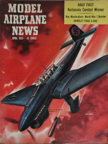
Junkers Ju-87 "Stuka"
Model Airplane News Cover Art for April, 1955
by Jo Kotula
Click to Enlarge
The Junkers Ju 87 or Stuka (from Sturzkampfflugzeug, "dive bomber") was a two-seat (pilot and rear gunner) German ground-attack aircraft. Designed by Hermann Pohlmann, the Stuka first flew in 1935 and made its combat debut in 1936 as part of the Luftwaffe's Condor Legion during the Spanish Civil War.
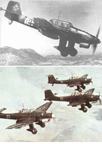
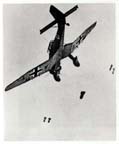
Photos of the Junkers Ju-87 "Stuka"
Click to Enlarge
The aircraft was easily recognizable by its inverted gull wings, fixed spatted undercarriage and its infamous Jericho-Trompete ("Jericho Trumpet") wailing siren. It should be noted here that the sound of this "trumpet" has become a cinematic cliche for all diving aircraft (or bombs). The trumpet was a horn-shaped appendage on the landing gear that sounded as air rushed through it. Without this special device, a dive bomber is relatively silent.
The JU-87 became the propaganda symbol of German air power and the Blitzkrieg victories of 1939-1942. The Stuka's design included several innovative features, including automatic pull-up dive brakes under both wings to ensure that the plane recovered from its attack dive even if the pilot blacked out from the high acceleration. Although sturdy, accurate, and very effective, the Ju 87 was vulnerable to modern fighter aircraft, like many other dive bombers of the war. Its flaws became apparent during the Battle of Britain; poor maneuverability, lack of speed and defensive armament meant that the Stuka required a fighter escort to operate effectively.
The Stuka operated with further success after the Battle of Britain, and its potency as a precision ground-attack aircraft became valuable to the German war effort in the Balkans Campaign, the African and Mediterranean Theaters and the early stages of the Eastern Front campaigns where Allied fighter resistance was disorganized and in short supply. However, once the Luftwaffe had lost air superiority on all fronts, the Ju 87 once again became an easy target for enemy fighter aircraft. In spite of this, because there was no better replacement, the type continued to be produced until 1944. By the end of the conflict, the Stuka had been largely replaced by ground-attack versions of the Focke-Wulf Fw 190, but was still in use until the last days of the war. An estimated 6,500 Ju 87s of all versions were built between 1936 and August 1944.
Here is a video of the Junkers Ju-87 "Stuka" in action:
Click Here for more information about the Junkers Ju-87 "Stuka".
For better or worse, the Stuka is an iconic airplane. Cleveland made a kit available with authentic details and markings. This design does not fly very well and generally built for historical reasons.
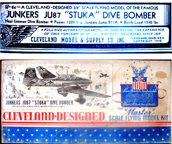
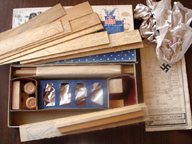
Cleveland Model of the Junkers JU-87 Stuka
Click to Enlarge
You can buy the plans and patterns that will enable you to make this model right now. Click Here to go to the exact location on the Cleveland Website to get them.
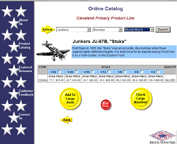
Junkers JU-87 "Stuka" at the Cleveland Site
Click to Enlarge

Click to go back and select another cover.
Counter for the Entire Site (not just this page..)
Home | About Lindy | Last Week's Reviews | Upcoming Events | 1940s Collecibles
The Guide - Establishments - Travel - Accessories
Music | Links | Photo Gallery | Extras | Contact